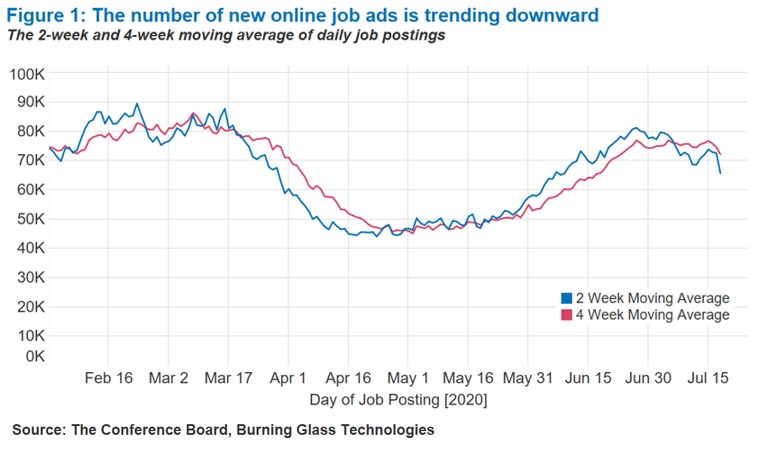The economy is struggling to keep up with the rise in coronavirus cases
27 Jul. 2020 | Comments (0)
After weeks of growth following the phased opening of businesses, the US economy is showing signs of slowing down. Many states are experiencing an increase in the number of COVID-19 cases and some have recently reimplemented restrictions, that had been lifted in May-June. In addition, many consumers may be reluctant to go out and spend when the risk of infection is elevated.
Has this weakness reached hiring?
The trend in the number of online job ads suggests that hiring is edging lower in recent weeks, according to our measure (Figure 1). The Conference Board®-Burning Glass® Help Wanted OnLine™ (HWOL) data series (Figure 1) collects millions of online job ads in real-time and classifies them, among other things, by location and occupation.

We should expect the additional restrictions on state economies to reduce hiring for several reasons:
First, there has been very little re-opening of businesses in recent weeks, and very little need to hire staff for re-opened businesses. Also, there are growing expectations of further restrictions and business closings which would make these business owners more reluctant to hire.
The widespread increase in new cases also drove home the message that the pandemic and the related economic crisis were far from over. Many were hoping that, come summer, the pandemic would gradually die down, but that is clearly not the case. As a result, businesses’ expectations regarding demand for the next year probably deteriorated. In such an environment, hiring would suffer.
Among the hardest hit jobs were those in food preparation and serving related occupations. In the initial phases of reopening restaurants and bars, a large demand for cooks, servers, bartenders and related jobs opened. Business that were once fully staffed were now in need of workers.
Most of these businesses are not operating a full capacity but were expected to by mid-summer. As the number of new confirmed coronavirus cases rose, states were forced to roll-back plans for things like indoor dining and capacity limits. Many states like Michigan and California have recently reimplemented restrictions, that had been lifted in June, as new confirmed cases started to rise again. As a result, the average number of daily job ads in July (July 5 to July 19) for Food Preparation and Serving Related occupation dropped by 30% relative to June (June 1 to June 28).
The number of ads for technology and engineering related jobs also experienced a large drop in recent weeks. It is not entirely clear why that is. Perhaps, the gloomier economic outlook for the next year may have muted the need to beef up staffing for new technology related projects.
Many states are experiencing an increase in the number of COVID-19 cases, but they are not necessarily the ones losing the most steam. Looking at online job postings, we can see where hiring is slowing down the fastest and the types of jobs shrinking in demand.
Shown in Figure 2, the whole country has experienced a decline in the average number of daily job ads relative to June 2020.
States in the south have been making headlines for their rise in confirmed coronavirus cases, but their economic slowdown is similar to the rest of the country. The Pacific division of the US experienced the largest change with a 17% drop. The Middle Atlantic, which includes hard hit states like New York and New Jersey, had the smallest change with a 11% drop in average daily job postings.

The economic slowdown will likely continue if the outlook for fully reopening the economy appears gloomy. Demand for workers is a function of current business needs as well as anticipated future needs. If companies and business owners fail to see the light at the end of the tunnel, the labor market will likely suffer.
-
About the Author:Agron Nicaj
Agron Nicaj is a former Associate Economist with The Conference Board’s Help Wanted OnLine (HWOL)© and Labor Markets programs. He was responsible for the production and analysis of the HWOL…
-
About the Author:Gad Levanon, PhD
The following is a biography of former employee/consultant Gad Levanon is the former Vice President, Labor Markets, and founder of the Labor Market Institute. He led the Help Wanted OnLine©…


0 Comment Comment Policy